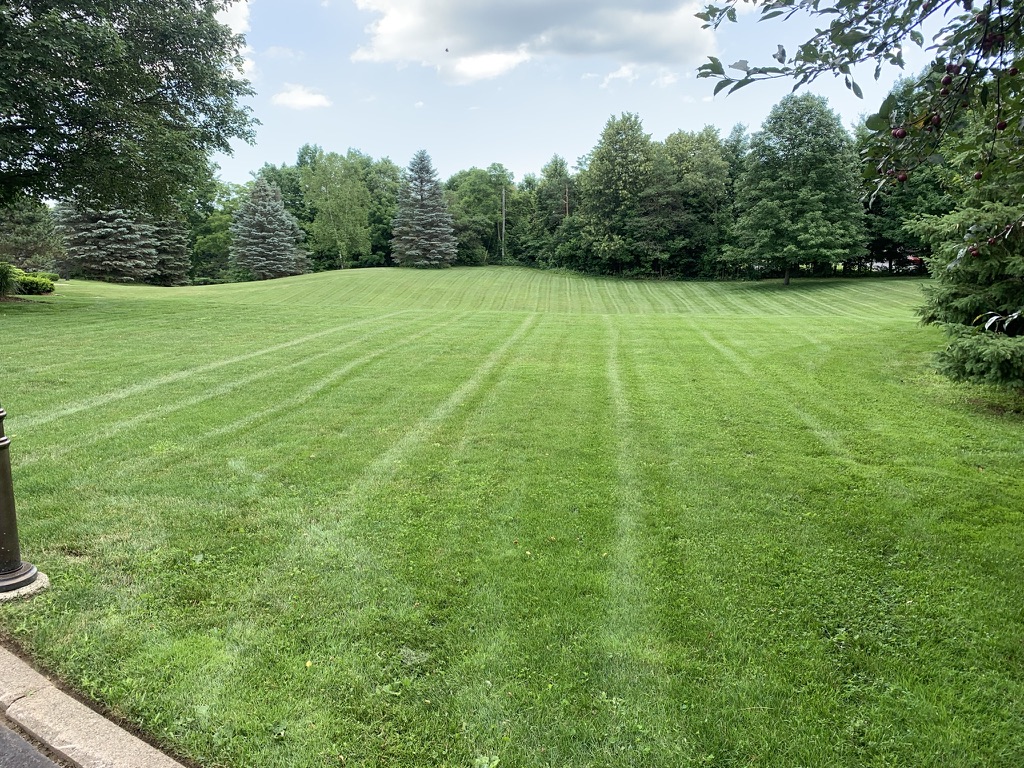Aerating your lawn is like giving it a breath of fresh air, essential for maintaining its health and vibrancy. But when’s the best time to undertake this task in Ontario? Timing is everything, and getting it right can make all the difference in achieving that lush, green carpet you’re aiming for.
In Ontario, with its unique climate and seasonal changes, pinpointing the ideal moment for lawn aeration requires a bit of insider knowledge. You’re in luck, as we’re here to guide you through the process, ensuring your lawn receives the care it needs at the perfect time. Let’s dive into the specifics and help you plan your lawn care schedule with confidence.
Importance of Aeration for Your Lawn
Aerating your lawn plays a pivotal role in maintaining its health and vitality. Over time, soil compaction prevents essential air, water, and nutrients from reaching the roots of your grass. This hinders the lawn’s ability to flourish and can lead to a variety of problems, including poor drainage, reduced drought tolerance, and greater susceptibility to pests and diseases.
Why is Aeration Necessary? Aeration involves creating small holes in the soil, breaking up compact layers and allowing the roots to breathe. It’s a key step in promoting deeper root growth, which is vital for a resilient and vibrant lawn. Deeper roots can access moisture and nutrients more effectively, helping your lawn withstand periods of dryness and reducing the need for frequent watering.
The benefits of aeration are manifold:
- Improved Air Exchange: Roots receive the oxygen they need to grow strong.
- Enhanced Water Uptake: Water penetration improves, reducing runoff and wastage.
- Better Nutrient Absorption: Fertilizers reach the root zone more efficiently.
- Thatch Breakdown: Helps decompose thatch layers, preventing harmful buildup.
Timing is everything when it comes to aeration. The best time to aerate your lawn in Ontario is during the growing season, when the grass can recover easily and fill in any open areas after soil plugs have been removed. Generally, for cool-season grasses prevalent in Ontario, early spring or fall are ideal. These periods offer a balance of warm days and cool nights – perfect conditions for grass recovery and growth.
Remember, aeration is not a one-size-fits-all solution. The type of soil, the grass species, and the level of use your lawn sees will influence how often aeration is needed. Most lawns benefit from annual aeration, but heavily used or clay-rich soils might need more frequent treatment.
Factors to Consider for Aeration Timing in Ontario

When deciding on the best time to aerate your lawn in Ontario, several factors play a pivotal role. Understanding these will ensure that you carry out lawn aeration at an optimal time, encouraging a lush, healthy lawn throughout the year.
Soil Type is a critical factor. Ontario’s soil can vary significantly from heavy clay to sandy loams. Clay soils are prone to compaction and generally require more frequent aeration, possibly once a year. In contrast, sandy soils suffer less from compaction and might need aeration less often. Identifying your soil type is a step you can’t skip.
The Grass Species in your lawn also affects aeration timing. Grasses in Ontario can be broadly categorized into cool-season and warm-season types. Cool-season grasses, prevalent in Ontario, thrive when aerated during their peak growth periods in early spring or fall. This timing supports rapid recovery and growth post-aeration.
Lawn Usage significantly impacts your aeration schedule. High traffic areas—like playgrounds or backyards that host frequent gatherings—compacts the soil more quickly. Such lawns benefit from more regular aeration to prevent the soil from becoming too dense and inhospitable for grass roots.
Don’t forget to consider Weather Conditions. Aeration is most effective when the soil is moist but not saturated. Aerating under extremely dry or wet conditions can harm your lawn rather than benefit it. Monitoring the weather forecast can help you pick the perfect day for aeration.
By taking into account these factors, you’re positioned to make an informed decision about the best time for aeration. Tailoring the timing to your specific lawn conditions will enhance the effectiveness of the aeration process, fostering the development of a robust, vibrant lawn.
Spring Aeration: Pros and Cons

When you’re pondering the best time for aeration in Ontario, spring emerges as a tempting choice. This season offers a unique set of advantages and challenges for your lawn care regimen.
The Pros of Spring Aeration
- Enhanced Growth: Aeration in spring can jump-start your lawn’s growth by increasing oxygen, water, and nutrient flow to the roots.
- Recovery from Winter Damage: The process helps your lawn recover from winter stress, promoting healthier, denser grass.
- Preparation for Summer: It prepares your lawn to endure the summer heat and potential drought conditions, making it more resilient.
- Weed Proliferation: Aerating your lawn in spring can inadvertently give weeds a foothold. The open spaces created invite weed seeds to germinate alongside your grass.
- Potential for Soil Compaction: Heavy spring rains can compact the soil soon after aeration unless timed impeccably, potentially undoing the benefits.
- Timing is Crucial: To avoid the cons while capitalizing on the pros, timing your aeration perfectly is critical. The soil should be moist but not overly wet, and the grass should be entering its peak growth phase.
In Ontario, the variability of spring weather means you’ll need to be both watchful and flexible. Monitor the local weather forecasts and soil conditions closely. Ideally, aim for aeration when there’s a clear stretch of moderately dry days after a light to moderate rainfall. This condition ensures the soil is ideally moist and less prone to further compaction or weed invasion.
In short, while spring aeration presents a promising opportunity for accelerating lawn recovery and growth, it demands careful timing and weather consideration. Proper execution can lead to a lush, vibrant lawn ready to face the summer ahead.
Fall Aeration: The Golden Opportunity

When considering the best time to aerate your lawn in Ontario, fall emerges as a golden opportunity that shouldn’t be overlooked. This season offers distinct advantages that can lead to a healthier lawn, setting the stage for lush growth in the spring.
During the fall, the cooler temperatures and occasional rainfall create an ideal environment for your lawn to recover and thrive. The soil moisture levels are typically more consistent, allowing for better penetration of the aeration tools. Unlike in spring, the weed pressure is significantly lower in the fall. This means that the open spaces left by aeration are less likely to be taken over by weeds, allowing for better grass seed germination and root development.
Another crucial aspect of fall aeration is its timing with the lawn’s natural life cycle. Grass tends to focus its energy on root growth during the cooler months. Aerating in the fall capitalizes on this growth phase, enhancing root depth and density. This process not only improves water and nutrient uptake before the harsh winter but also prepares the lawn for robust growth when spring arrives.
To maximize the benefits of fall aeration, timing is critical. Target a period when the grass is still growing but the peak heat of summer has passed. This usually falls between early September and late October in Ontario. Ensure the soil is moist but not saturated, as this condition delivers the most effective aeration results.
Fall aeration stands out as a prime time to invest in the health of your lawn. It leverages the natural conditions and growth cycles for maximum benefit, paving the way for a vibrant, resilient lawn in the upcoming seasons.
Best Practices for Aeration in Ontario
When you’re ready to aerate your lawn, timing isn’t the only factor that counts. To ensure the best outcomes, adopting specific aeration practices tailored to Ontario’s unique conditions is crucial. Let’s dive into how you can maximize the benefits.
Firstly, choose the right aeration method. There are two main types: spike and plug (core) aeration. Spike aeration simply punches holes into the ground, whereas plug aeration removes small cores of soil and thatch from your lawn. For Ontario lawns, plug aeration is generally more effective. It reduces soil compaction more efficiently and facilitates deeper root growth.
Irrigation plays a pivotal role before and after aeration. Ensure your lawn is adequately watered a few days prior to aeration. This preparation makes the soil easier to penetrate. Post-aeration, light watering helps to speed up the recovery process, encouraging grassroots to grow into the newly created spaces.
Overseeding is another key step that complements aeration, especially in fall. After aerating, spreading a mixture of grass seed over your lawn can help fill in bare patches and improve overall density and color. Select a seed mix that is suited to Ontario’s climate and your specific lawn conditions.
Lastly, fertilization after aeration can significantly boost your lawn’s health. Since aeration improves the soil’s receptiveness, applying fertilizer afterwards ensures nutrients reach deeper into the ground, directly benefiting the roots. Opt for a fertilizer tailored to your lawn’s nutritional needs, considering the time of year and your soil’s specific requirements.
By following these best practices, you’re not just aerating your lawn; you’re setting the stage for a more vibrant, resilient, and healthier green space that responds better to Ontario’s changing seasons.
Conclusion
Choosing the optimal time to aerate your lawn in Ontario is just the beginning. By selecting plug aeration, you’re setting the stage for deeper root growth and improved soil structure. Remember, the effort you put into pre and post-aeration care, including proper irrigation and timely overseeding, will significantly influence your lawn’s health. Don’t overlook the power of fertilisation to boost nutrient absorption and enhance your lawn’s resilience against Ontario’s diverse climate. With these steps, you’re not just aerating; you’re investing in a lush, vibrant lawn that stands the test of time.
Frequently Asked Questions (FAQ)
What is the best aeration method for lawns in Ontario?
Plug aeration is recommended over spike aeration for reducing soil compaction and promoting deeper root growth effectively.
Why is proper irrigation important before and after aeration?
Proper irrigation before aeration helps with soil penetration, and watering after aeration aids in recovery and encourages root growth.
How does overseeding benefit the lawn after aeration?
Overseeding post-aeration helps fill in bare patches, increases lawn density, and improves the lawn’s colour and appearance.
Why is fertilisation recommended after aeration?
Fertilisation post-aeration enhances soil receptiveness and allows nutrients to reach deeper into the ground, leading to a healthier and more resilient lawn.


